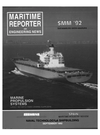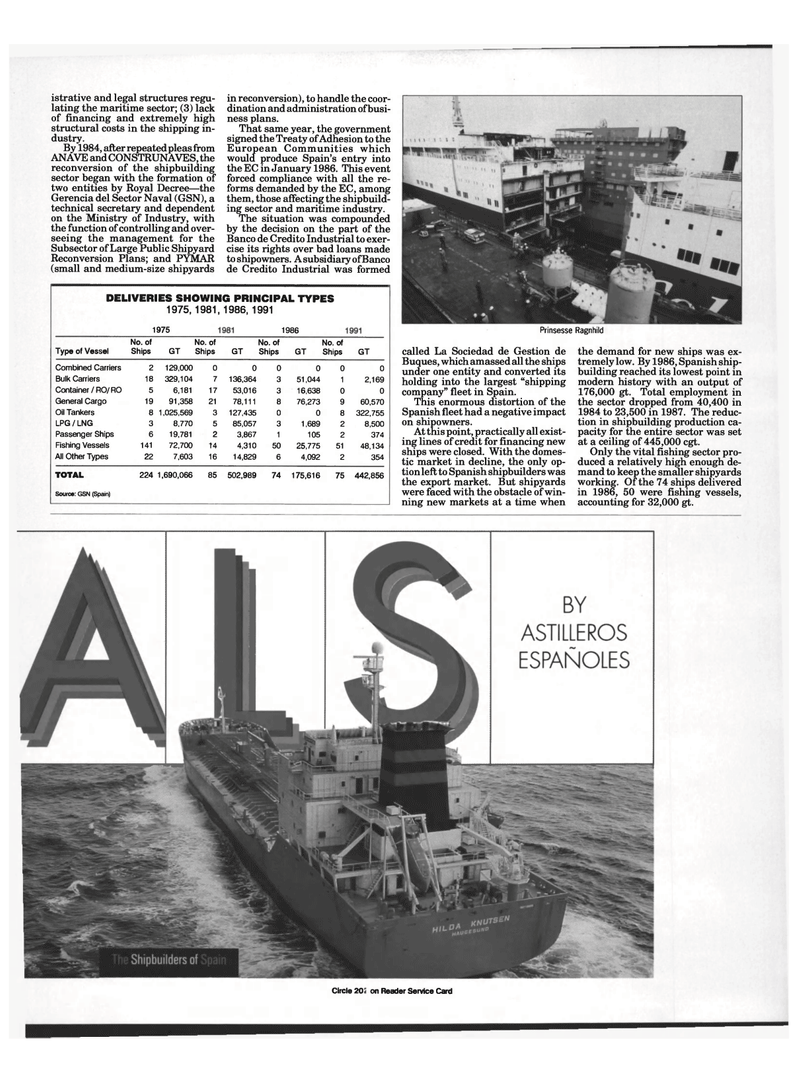
Page 21: of Maritime Reporter Magazine (September 1992)
Read this page in Pdf, Flash or Html5 edition of September 1992 Maritime Reporter Magazine
DELIVERIES SHOWING PRINCIPAL TYPES 1975, 1981, 1986, 1991 1975 1986
No. of No. of No. of No. of
Type of Vessel Ships GT Ships GT Ships GT Ships GT
Combined Carriers 2 129,000 0 0 0 0 0 0
Bulk Carriers 18 329,104 7 136,364 3 51,044 1 2,169
Container /RO/RO 5 6,181 17 53,016 3 16,638 0 0
General Cargo 19 91,358 21 78,111 8 76,273 9 60,570
Oil Tankers 8 1,025,569 3 127,435 0 0 8 322,755
LPG / LNG 3 8,770 5 85,057 3 1,689 2 8,500
Passenger Ships 6 19,781 2 3,867 1 105 2 374
Fishing Vessels 141 72,700 T4 4,310 50 25,775 51 48,134
All Other Types 22 7,603 16 14,829 6 4,092 2 354
TOTAL 224 1,690,066 85 502,989 74 175,616 75 442,856
Source: GSN (Spain)
Prinsesse Ragnhild called La Sociedad de Gestion de
Buques, which amassed all the ships under one entity and converted its holding into the largest "shipping company" fleet in Spain.
This enormous distortion of the
Spanish fleet had a negative impact on shipowners.
At this point, practically all exist- ing lines of credit for financing new ships were closed. With the domes- tic market in decline, the only op- tion left to Spanish shipbuilders was the export market. But shipyards were faced with the obstacle of win- ning new markets at a time when the demand for new ships was ex- tremely low. By 1986, Spanish ship- building reached its lowest point in modern history with an output of 176,000 gt. Total employment in the sector dropped from 40,400 in 1984 to 23,500 in 1987. The reduc- tion in shipbuilding production ca- pacity for the entire sector was set at a ceiling of 445,000 cgt.
Only the vital fishing sector pro- duced a relatively high enough de- mand to keep the smaller shipyards working. Of the 74 ships delivered in 1986, 50 were fishing vessels, accounting for 32,000 gt. istrative and legal structures regu- lating the maritime sector; (3) lack of financing and extremely high structural costs in the shipping in- dustry.
By 1984, after repeated pleas from
ANAVE and CONSTRUNAVES, the reconversion of the shipbuilding sector began with the formation of two entities by Royal Decree—the
Gerencia del Sector Naval (GSN), a technical secretary and dependent on the Ministry of Industry, with the function of controlling and over- seeing the management for the
Subsector of Large Public Shipyard
Reconversion Plans; and PYMAR (small and medium-size shipyards in reconversion), to handle the coor- dination and administration of busi- ness plans.
That same year, the government signed the Treaty of Adhesion to the
European Communities which would produce Spain's entry into the EC in January 1986. This event forced compliance with all the re- forms demanded by the EC, among them, those affecting the shipbuild- ing sector and maritime industry.
The situation was compounded by the decision on the part of the
Banco de Credito Industrial to exer- cise its rights over bad loans made to shipowners. A subsidiary of Banco de Credito Industrial was formed
Circle 200 on Reader Service Card ^Signal

 20
20

 22
22
